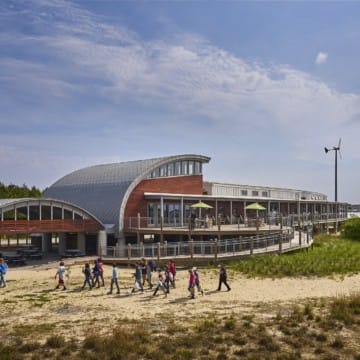Burbank Water and Power EcoCampus
A community-owned public utility site, the Magnolia Power Project at Burbank Water and Power (BWP) EcoCampus is the first power plant in the world to operate on 100 percent recycled water. The surrounding landscaping of the 3.2-acre campus, designed by AHBE Landscape Architects, incorporates a wide range of green infrastructure techniques that retain and manage stormwater, filtering it through a treatment system that recycles the water to assist in efficient, cost-effective electricity generation for the municipality. At a time of drought in California, BWP’s leadership in water management has set an example and shown that sustainable design can thrive in an urban industrial context.
Context
Burbank Water and Power has served Burbank for more than 100 years. In the late 1990s, facilities were aging, increasing maintenance costs and resulting in inefficiencies and higher utility rates for residents and businesses. In fact, rates in 2000 were near the top in the region as compared to other municipal-owned utilities. The site was also more than 79 percent impervious surfaces and the high temperatures and low precipitation meant that few plants could survive on site.
The campus invested in a major redesign in 2000 to modernize to an efficient utility operation incorporating green infrastructure to achieve goals of lower operating costs and keep rate increases under the rate of inflation while creating a competitive employment advantage. Today, BWP boasts some of the lowest rates for utilities in southern California. The utility also sees the campus redevelopment project as enhancing its brand, improving its recruitment capabilities, particularly given the utility’s high visibility on an urban site.
The campus redesign responded to the new city development codes, including on-site mitigation requirements, requiring projects to retain 0.75 inches during a 24-hour rain event. The 15-year project adjusted its design based on the industry’s understanding of sustainability to maintain efficient operations.
Innovative Water Management Features
Today’s BWP’s EcoCampus ecologically manages stormwater, uses solar power, reduces urban heat-island effects, and reuses materials throughout the campus. In total, the campus uses five different water filtration technologies: detention, rainwater capture, infiltration, flow-through cells, and tree root cells. Key aspects of the campus landscape redesign included primary landscaping, a green street implemented in 2010, and an employee courtyard that repurposes old industrial structures from a decommissioned electrical substation. Campus facilities include three LEED Platinum buildings topped with white and green roofs. Water management features within the EcoCampus include the following:
- Recycled water treatment system. The Magnolia Power Project’s recycled water treatment system eliminates use of more than 1 million gallons a day for cooling towers and steam turbine generation with no discharge into the Pacific Ocean.
- Green street. Lake Street was initially a green street demonstration project, serving as an educational tool about sustainable design and demonstrating how green infrastructure can be artfully incorporated. The street includes permeable pavers and filtration planters.
Value Proposition
The key success factor for BWP was the improved operations, which led to more affordable utility rates for the citizens of Burbank, who are customer-owners of the utility. Burbank’s investment in green infrastructure has also led to net-zero stormwater runoff from the campus and 100 percent recycled water use for all landscaping, reducing piped water use by as much as 100,000 gallons per day. Green roofs, which absorb up to 70 percent of rainwater, help the facility save an estimated $14,000 per year.
Burbank’s leadership has linked improved morale and recruiting to the campus enhancements. Previously, the campus lacked green space and spaces for employees to gather and exchange ideas. The improved campus has contributed to success in recruiting a younger generation of talent and generated substantial publicity for the utility, including numerous awards, certification by the Sustainable Sites Initiative, and regular visits from the global business community.
“[BWP] realized that new generations were in tune with the environment and that the younger generation wanted to work for an organization that had values similar to theirs.” Joe Flores, Marketing and Public Information Officer, Burbank Water and Power
Lessons Learned
- Investment in a green facility positively affected the bottom line and prices for consumers. Burbank’s investment in using recycled water and sustainable design measures has been incorporated into operational efficiencies that contribute to the bottom line and ultimately to some of the lowest utility rates in southern California.
- Green design can contribute to corporate identity, branding, and talent retention. BWP has attributed recent recruiting and talent attraction to the brand recognition that in part has come from the green campus.
- Green infrastructure can be effectively incorporated into a tightly constrained urban site. The project sought to not only educate the public on green infrastructure, but also show what could be possible in both an urban and industrial context, preserving industrial structures within the campus.
- BWP’s leadership in green design and water management has helped the city at a time of water scarcity. Burbank met the “billion-gallon challenge” for water savings ahead of schedule after Governor Jerry Brown’s call for water conservation in the face of the state’s drought crisis. BWP’s example has been part of this city and statewide focus on water conservation and stewardship.


